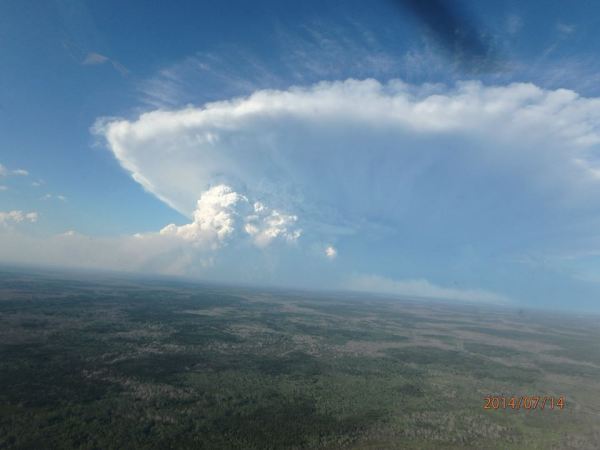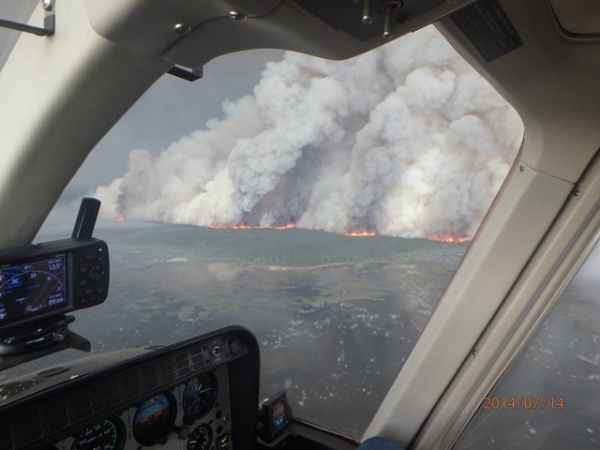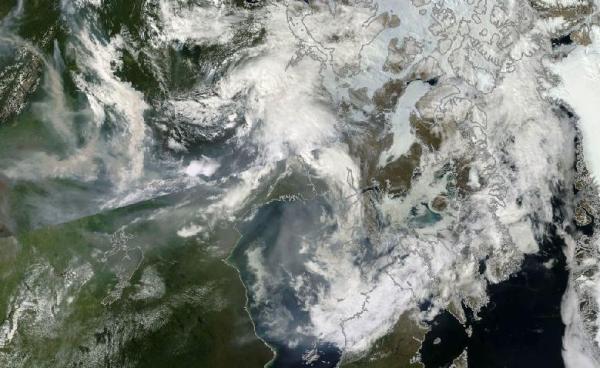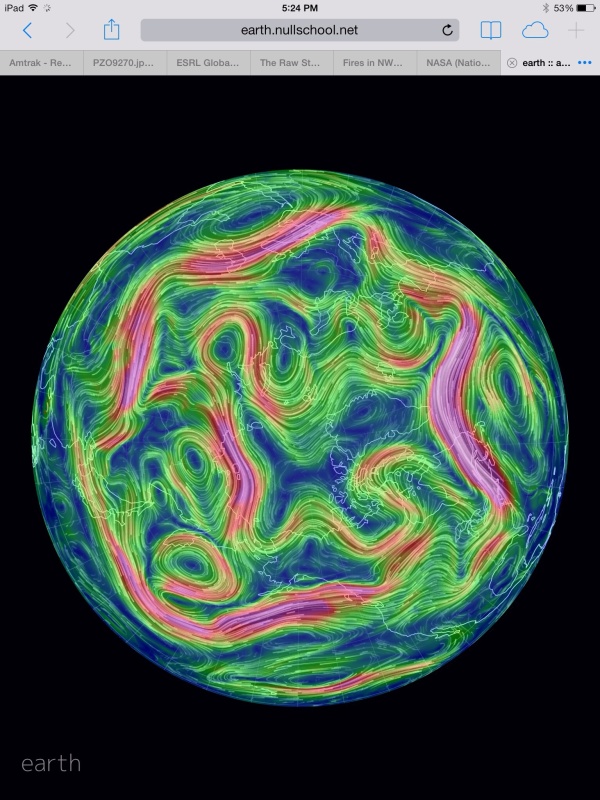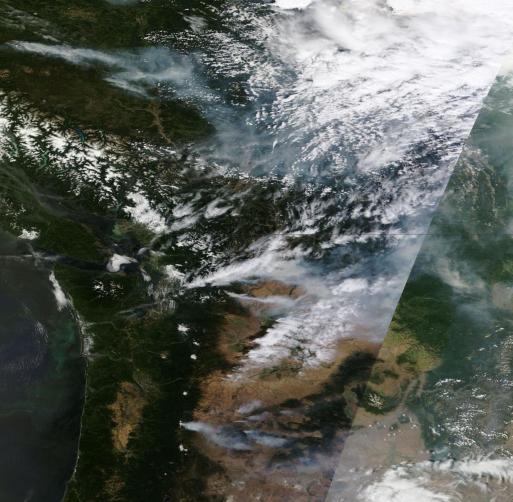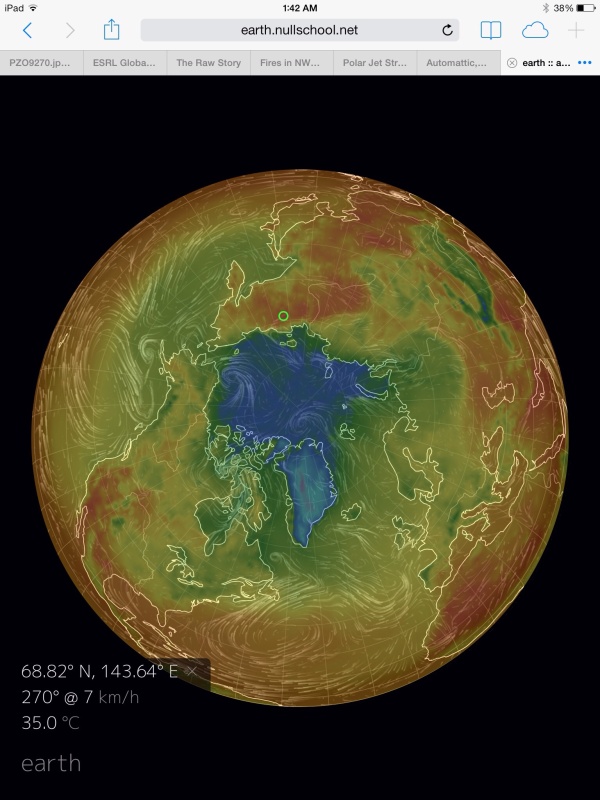This year, the warm air invasion started early. A high amplitude ridge in the Jet Stream stretching for thousands of miles over the temperate Pacific and on up into Alaska and the Chukchi Sea slowly drifted eastward. Reinforced by a powerful bank of blocking high pressure systems over the northeastern Pacific, this ridge settled over Canada’s Northwest Territory in a zone from the Mackenzie Delta and over a broad region east and south. From mid June onward, temperatures in the 70s, 80s and even low 90s dominated sections of this Arctic region.
The heat built and built, drying the shallow soil zone over the thawing permafrost creating a tinder-dry bed layer waiting for the lightning strikes that were bound to follow in the abnormal Arctic heat.
By late June, major fire complexes had erupted over the region. Through early and mid July, these massive systems expanded even as the anomalous heat dome tightened its grip. Today, the fires in Northwestern Canada have reached a horrific intensity and one, the Birch Complex fire, alone has now consumed more than a quarter of a million acres.
According to reports from Canada’s Interagency Fire Center, total acres burned to date are more than six times that of a typical year. A rate of burning that, according to a recent scientific study, is unprecedented not just for this century, but for any period in Canada’s basement forest record over the last 10,000 years.
(Thunderstorm? No. Smoke from a major volcanic eruption injecting ash into the stratosphere? No. The upper frame shot is an aerial photo taken of the Birch Creek Fire Complex on July 14, 2014 from a distance of about 30 miles away. It is just one of the massive fires now raging in the Northwest Territory region of Canada. A closer picture, taken from a few miles out, reveals the flaming base of a massive smoke plume. Image source: NWT Fire Facebook.)
From helicopter and airplane, the volume of smoke pouring out of these massive tundra and boreal forest fires is amazing, appearing to mimic major thunderstorm complexes or volcanic eruptions. Closer shots reveal towering walls of flame casting billows of smoke thousands of feet into the air above.
The smoke from these fires, now numbering in excess of 186 separate blazes, is becoming entrained in the weakening circumpolar Jet Stream. The steely gray billows now trail in a massive cloud of heat-trapping black carbon that stretches more than 2000 miles south and east. Its southern-most reaches have left residents of the northwestern and north-central US smelling smoke for weeks, now. Meanwhile, the cloud’s eastern-most reaches approach Baffin Bay and the increasingly vulnerable ice sheets of Greenland.
(Satellite shot of smoke from massive fire complexes over Canada spreading eastward. Black carbon and related CO2 emissions from forest fires can serve as a powerful amplifying feedback to already dangerous human-caused climate change. Image source: NASA/LANCE-MODIS.)
Across the Arctic, Siberia Also Burns
As media attention focuses on the admittedly horrific fires of unprecedented magnitude raging over Canada, a second region of less well covered but possibly even more extensive blazes burns on the other side of the Arctic Ocean throughout the boreal forest and tundra zones of Central Siberia in Russia.
There, record heat that settled in during winter time never left, remaining in place throughout summer and peaking in the range of 80-90 degree Arctic temperatures over the past couple of weeks. Over the last seven days, massive fires have erupted which, from the satellite vantage, appear about as energetic as the very intense blazes that ripped through Siberia during the record summer fire year of 2012. It is a set of extreme conditions we’ve been warning could break out ever since March and April when intense early season fires ripped through the Lake Baikal and Southern Yedoma regions.
Now, what appears to be more than 200 fires are belching out very thick plumes of smoke stretching for more than 2000 miles over North-Central Siberia and on into the recently ice-free zone of the Laptev Sea:
(Massive sea of smoke and fire stretching from Lake Baikal and northeast over Central Siberia and on into the Arctic Ocean. Image source: NASA/LANCE-MODIS.)
As with the other set of fires in Canada, the smoke from these massive blazes is entraining in the Jet Stream and stretching across Arctic regions. An ominous blanket of steely gray for the roof of the world and yet one more potential amplifying heat feedback the Arctic certainly does not need.
Potential Amplifying Feedbacks in Context
During recent years, scientists have been concerned by what appears to be an increased waviness and northward retreat of the northern hemisphere Jet Stream. This retreat and proliferation of ridge and trough patterns is thought to be a result of a combined loss of snow and sea ice coverage over the past century and increasing over the past few decades. In 2012, sea ice coverage fell to as low as 55% below 1979 levels with volume dropping as low as 80% below previous values. Over the past seven years, not one day has seen sea ice at average levels for the late 20th Century in the north.
Meanwhile, northern polar temperatures have risen very rapidly under the rapidly rising human greenhouse gas heat forcing, increasing by 0.5 C per decade or about double the global average. It is this combination of conditions that set the stage for fixed ridges over both Russia and Canada creating extreme risk for extraordinary fires.
(Weak and wavy polar jet stream on July 17, 2014 shows fixed ridges over the Northwest Territory, Central and Eastern Siberia, Northern Europe and the adjacent North Atlantic and Arctic. Image source: Earth Nullschool. Data Source: NOAA GFS and various.)
Should both the current sets of fires continue to rage under anomalous high amplitude jet stream waves setting off extreme heat in these Arctic regions, it is possible that large clouds of heat absorbing black carbon could ring the Arctic in a kind of hot halo. The dark smoke particles in the atmosphere would trap more heat locally even as they rained down to cover both sea ice and ice sheets. With the Canadian fires, deposition and snow darkening are a likely result, especially along the western regions of the Greenland Ice Sheet — zones that have already seen a multiplication of melt ponds and increasing glacial destabilization over recent years.
Recent scientific studies have also highlighted the possibility that human-caused climate change is increasing high amplitude jet stream ridge patterns that are transporting more and more heat into Arctic tundra and boreal forest regions. These regions are more vulnerable to fires due to the fact that trees in boreal forest have uniform characteristics that favor burning and tend to rapidly ignite and spread once the upper branches become involved. The unfrozen soil features a narrow basement layer above tundra which dries more rapidly than the soils of more temperate areas, providing tinder fuel to aid in the initial ignition by lightning strike. Thawing, deeper tundra, when dried, is a meters-deep pile of fuel that has accumulated for thousands of years — a kind of peat-like layer that can smolder and re-ignite fires that burn over very long periods. It is this volatile and expanding basement zone that is cause for serious concern and greatly increases the potential fire hazard for thousands of miles of thawing tundra going forward.
Overall, both boreal forest and thawing tundra provide an extraordinary potential fuel for very large fire complexes as the Arctic continues to warm under the human greenhouse gas forcing. And though climate models are in general agreement that the frequency of fires in tundra regions will increase, doubling or more by the end of this century, it is uncertain how extensive and explosive such an increase would be given the high volume of fuel available. Direct and large-scale burning of these stores, which in tundra alone house about 1,500 gigatons of carbon, could provide a major climate and Earth System response to the already powerful human heat forcing.
Though the science at this point is uncertain, we observe very large and unprecedented fire outbreaks with increasing frequency:
“I think it’s really important for us to take advantage of studying these big disturbance events,” noted Dr. Jill Johnstone in a recent interview. “Because, if we can say anything, we can say that we think they’re going to be more common.”
UPDATE:
The smoke plume over North America has now expanded to cover a large section of the continental land mass. As you can see in the image below provided by NOAA, the smoke plume now stretches from the fire zones in the Northwest Territory (fires indicated by red dots), British Columbia, Washington, Oregon and California across much of the North American continent extending as far to the north and east as the southern tip of Greenland and as far to the south and east as Maryland, West Virgina and Tennessee:
(Massive North American Smoke Plume fed by Tundra and Western Forest Fires. Image source NOAA.)
As of today and yesterday (17 and 18 July) major wildfires continued to burn over much of the Northwest Territory of Canada even as these very large and unprecedented fire complexes were joined by massive outbreaks in British Columbia, Washington and Oregon. Fire outbreaks were so extreme in both Washington and Oregon that state officials there were forced to declare states of emergency and seek federal assistance for dealing with the ongoing disasters.
You can see the large, steely-gray smoke plumes from these fires in the LANCE MODIS image taken by NASA yesterday in the satellite shot below:
(Massive wildfires in Washington and Oregon prompt officials to issue disaster warnings. Image source: LANCE-MODIS.)
The smoke has become so pervasive that commenter James Cole has made some rather stark observations from Northern Minnesota:
A sky filled with grey haze, you can hardly tell there is a sun up there. No clouds in the sky, but the haze is incredible. Surely from the great Canadian fires!
Due to black carbon loading, such a large cloud of smoke may result in substantial temperature spikes over regions affected. The heat dome over the US West is expected to expand into the central and northern US this weekend with some readings there predicted to reach the 100s. Already, the southwestern heat is spreading north and eastward under the dome of heat-intensifying smoke with a broad area of upper 80s and lower 90s stretching all the way to the southern shores of Hudson Bay.
Meanwhile, on the other side of the Arctic, the expanse of wildfires continued to widen with the smoke plume now covering over 2,500 miles and with multiple very large blazes continuing over Central and Northeastern Siberia. Atmospheric black carbon and methane loading (more in a new post) likely contributed to temperatures in the range of 95 degrees F (35 C) near the shores of the Arctic Ocean’s Laptev Sea yesterday as recorded in the following screen capture from Earth Nullschool/GFS:
(35 C temperature [95 F] recorded in northeastern Siberia near the Laptev Sea at about 12:30 AM EST on July 18. Image source: Earth Nullschool. Data Source: NOAA/GFS.)
Links:
Fires in Northwest Territories in Line with Unprecedented Burn
What Fires in the Northwest Territories Say About Climate Change
Recent Burning of Boreal Forest Exceeds Fire Regime Limits of Past 10,000 Years (PNAS)
Arctic’s Boreal Forests Burning at Unprecedented Rate
Large Particles From Wildfire Soot Found to Trap 90 Percent More Heat Than Small Particles
North American Smoke Plume Tracking by NOAA
Hat tip to Wili
Hat tip to James Cole

